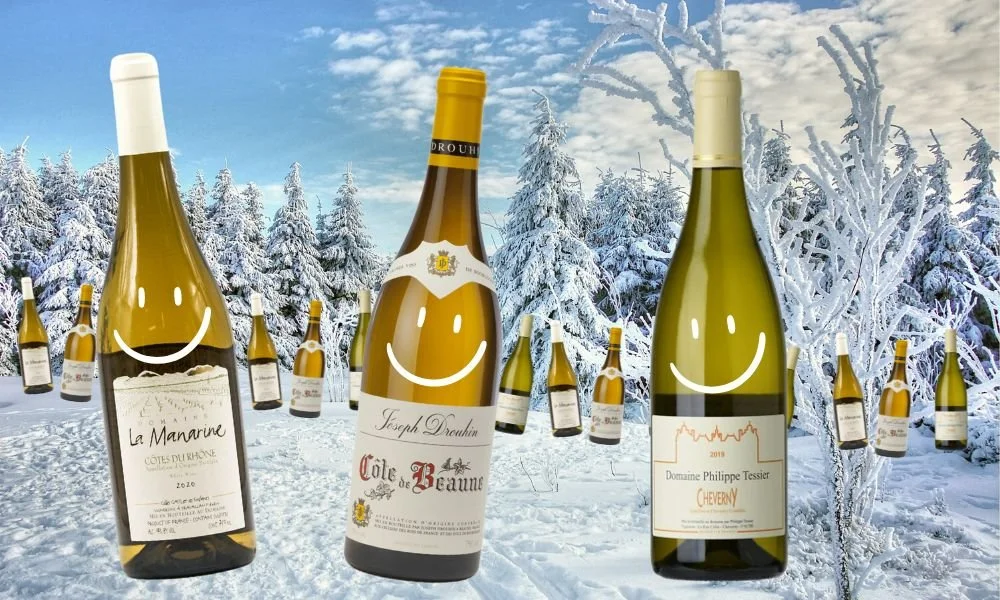Cozy white wines for winter weather
For as long as we can all remember wine is about color:
Whites (and rosés) are to be drunk cold; they are for the warm months *queue straws, sunglasses, and kiddie pools*
And reds are for cozying up next to the fireplace *queue snow falling outside the window, wooly blankets, warm, beefy stews*
This is nice and all. But it also can get a bit boring. Do we ALWAYS have to abide by the tropes—as cute as they seem??
No! Not only do we never have to abide by convention, we’re dealing with a fallacy here anyway.
The fact that red wines are for winter and white wines are for summer is based on the idea that reds are to be served at room temperature and whites should be at fridge temperature.
This is one of the biggest misconceptions about wine and drinking!
The serving temperature of wine actually has nothing to do with a wine’s color.
We’ve already discussed this with the chilled reds. Reds are for summer, too.
But wait, whites that aren’t served ice cold? 100%!
In fact, serving any wine or beverage too cold completely mutes the flavors. (Why do you think cheap beer brands tell you in all their marketing to drink their products “ice cold”?)
Drinking wines—yes, even some whites, warmer—will allow flavor aromas to move around so that you can actually smell, taste, and experience the wine.
The serving temperature of a wine is determined by its weight*
The weight, or body, of the wine is part of the wine’s structure. It refers to how heavy or light it feels in your mouth (think about the difference between water versus whole milk or half and half). A wine could be ‘light-’, ‘medium-’, or full-bodied’.
A lighter-bodied wine should be served colder (say, 45-50 degrees). This includes your light, piercing, refreshing, high-acid zinger you loved chugging on your porch six months ago. And this also includes our summer-friendly chillable reds. (See how color here is irrelevant?)
A fuller-bodied wine should be served 52-60F. This includes all but the heaviest and most tannic reds, as well as many whites that are sadly overlooked and underappreciated during the winter months.
The serving temperature of a wine is determined by its weight, NOT its color as commonly thought.
What are some full-bodied, winter-friendly whites to look for?
👉 Chenin Blanc!
Especially from the Loire Valley (France). The cool climate keeps this sometimes overly luscious grape crisp and bright.
Think honey, lots o’ minerality, beeswax, chamomile, and wet wool. Look for whites from subregions Vouvray (make sure it says “sec” to ensure it's a dry version), Saumur, Chinon, or Savennieres.
👉 Southern Rhone white blends
Most of us are familiar with ye ol’ Cotes du Rhone GSM (Grenache, Syrah, Mouvedre) red blend, but have you explored the whites?
The white blends are primarily made up of Grenache Blanc, Marsanne, Roussanne, and Viognier. Full-bodied and notes of ripe apricot and peach, candied citrus, bits of honey and straw and super floral like honeysuckle and herbal tea.
👉 Furmint or Harslevelu from Hungary
Look for Furmint or Harslevelu. Most famously made into a sweet wine called Tokaji Aszu, there are dry versions, too!
Look for Furmint for more round notes of lemon, green apple, ginger and smoke, and Harslevelu if you prefer lime, flowers, herbaceousness and peppery spice.
👉 Chardonnay from California or Burgundy
Go to California if you want the old-school oak-and-buttery style, which will have all the heft you need.
Or try one from Burgundy, France - Though some folks love the fresh ‘n’ flinty feel of a Chablis all year round, something a little heavier may be more appropriate for the cooler months. Look for a Côte de Beaune, a Chardonnay that is typically lush and creamy from being subtly oaked. Older examples will have a wonderful nuttiness about them as well.
Bonus: Try an orange wine.
Orange wine is a white wine with skin contact. Read up on wtf that means here.
If you wanna get real crazy these are the ultimate winter whites! Not only are they fuller bodied, but they also have tannin (which is usually only present in red wines, not whites) which means they drink more like a red wine than a white wine.
If you’ve never had an orange wine, here are some quick tips:
👉 Brace yourself. They can be kind of crazy.
👉 Treat them like a red wine. Drink them even warmer than a full-bodied white.
👉 Drink lighter versions at 50-53 degrees, and heavier ones at 53-57 degrees.
👉 Discover and shop for orange wine like a pro: Download your free guide here!
The winter-wine world is your oyster in more ways than you think!
What winter white are you going to try first? Do you have another winter white recommendation? Comment below!
*Note, if it’s red then you might have to factor in the amount of tannin as well.
P.S. To take part in the making of The Ultimate Natural Wine Course and get lots more members-only bonuses, join our super-cool membership, Sunday School Wine Society!








Champagne doesn’t always have to crowd the spotlight. There is a sparkling wine out there that is the perfect go-to bubbly that will consistently impress your friends, please your palate, and not burn holes in your pockets. Find out our absolute favorite bubbly for when you’re a lush on a budget.